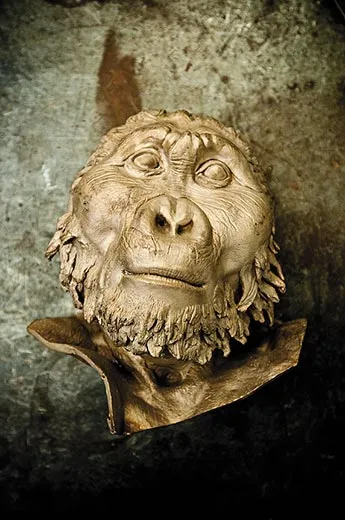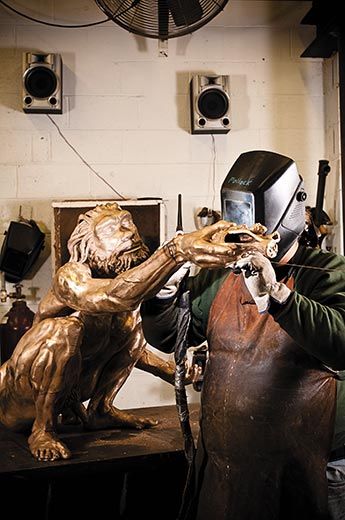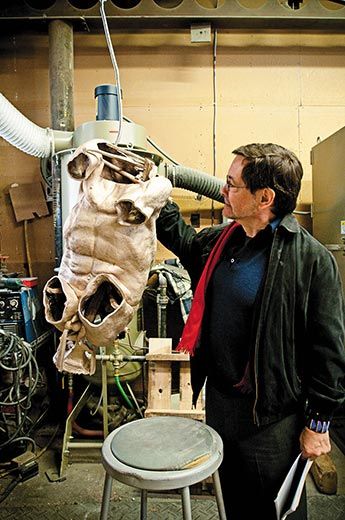Sculpting Evolution
A series of statues by sculptor John Gurche brings us face to face with our early ancestors
/https://tf-cmsv2-smithsonianmag-media.s3.amazonaws.com/filer/Homo-heidelbergensis-sculpture-631.jpg)
Rick Potts peers expectantly into the face of Homo heidelbergensis—“Mr. Heidi,” the anthropologist calls the bronze statue of our 700,000-year-old ancestor. “There’s the brow ridge!” Potts exclaims, as a worker at Baltimore’s New Arts Foundry chips away at the ceramic cast covering the sculpture’s features. “And the nose!”—which was large and raised, allowing H. heidelbergensis to warm the air it inhaled, an adaptation for cold environments. One by one, tufts of beard are chiseled free, and the sculpture’s eyes, now wiped clean of dust, project a keen metallic gaze. H. heidelbergensis isn’t smiling, exactly (those facial muscles had yet to evolve), but his expression is tentative—almost kindly. “Hopeful,” Potts calls it.
Once installed alongside four other sculptures of early humans at the National Museum of Natural History’s David H. Koch Hall of Human Origins—which opens March 17 to celebrate the museum’s 100th anniversary—the finished H. heidelbergensis will crouch over a fire, preparing a piece of roast like any modern barbecue maestro (except that Mr. Heidi is completely naked).
To help us imagine our distant ancestors, Potts, the director of the museum’s Human Origins Program, and sculptor John Gurche condensed a two-million-year period of human evolution into a series of five bronzes. But they rejected the clichéd visual timeline of slouchy ape gradually transforming into a Homo sapiens with ramrod posture. Rather, the museum’s sculpture series tells a less linear story, Potts says, that challenges “the inevitability of us.”
Upon entering the exhibit hall, you’ll first see a tableau that includes lanky Homo erectus, who emerged 1.8 million years ago. She will be gripping a stone tool and lumbering along with a dead antelope on her back. Gurche sculpted a female, Potts explains, because the most complete skull for Gurche to study was female. Also, “we wanted to contest the idea of males bringing home the bacon.”
H. erectus will be eyeing a statue of her contemporary, Paranthropus boisei, an insatiable vegetarian whom Gurche calls a “chewing machine” and who lived between 2.3 million and 1.2 million years ago. P. boisei, who has massive jaw muscles and teeth, tugs at an unappetizing-looking root. His hands are human, but his gaze is slightly bovine, and he seems oblivious to everything except his tubers. “Paranthropus” means “next to man”; he is not a direct ancestor of contemporary humans, and after a million years, his species died out.
Next comes H. heidelbergensis (who likely harnessed fire), followed by a Neanderthal (Homo neanderthalensis) mother and child, who would have lived some 60,000 years ago. As the toddler peers over her shoulder, the mother is preparing hides for her family to wear. (Clothing at last!) Neanderthals were socially developed enough to bury their dead.
Another statue portrays a less exalted relation: tiny Homo floresiensis, who had a wee brain and huge feet and ate rats and lizards. “Flo,” as Gurche sometimes calls her, is shown recoiling in terror from something—perhaps a cloud of volcanic ash that blanketed the Indonesian island where her kind lived a mere 18,000 years ago. Doomed H. floresiensis “suggests we’re more fragile than we thought,” Potts says.
The sculptures emphasize that our predecessor species did not simply succeed one another, each hominid more evolved than the last. Rather, several overlapped in time—P. boisei with H. erectus, and early H. floresiensis with the late Neanderthals—adopting different survival strategies as they competed for resources. By featuring oddball cousins such as P. boisei and H. floresiensis—as opposed to possible direct ancestors like Australopithecus africanus—the exhibit demonstrates that modern humans, with our jumbo brains, are just another iteration of this family tree, and not evolution’s inevitable grand finale.
Seeing the exquisite artwork, though, it is hard not to feel the slightest bit smug about our species’ accomplishments. As we toured the Baltimore foundry, we watched the mold of Mr. Heidi’s torso being fired in the kiln.
“There’s a touch of pyromania about this business,” remarks foundry owner Gary Siegel as we admire the licking flames.
“It all started with heidelbergensis,” Potts responds.


